Apology Letter for Miscommunication
Dear [Recipient's Name],
I hope this letter finds you well. I am writing to offer my sincere apologies for the miscommunication that occurred between us recently. I deeply regret any confusion or inconvenience that my words or actions may have caused.
It was never my intention to create misunderstandings or disrupt the flow of information. I understand the importance of clear and effective communication in our professional relationship, and I accept full responsibility for any part I played in the miscommunication.
I acknowledge that my words or actions might have conveyed a different meaning than what I intended, and for that, I am truly sorry. I assure you that I value our working relationship and the contributions each of us brings to the table.
In order to rectify this situation and prevent similar occurrences in the future, I have taken some steps to improve my communication skills. I have enrolled in a professional communication course, which will help me better understand the impact of my words and develop strategies for effective communication.
Furthermore, I am committed to working closely with you and the team to ensure that our lines of communication remain open and transparent. I will actively seek clarification when needed and provide concise and accurate information to avoid any further miscommunication.
Please accept my sincere apology once again. I genuinely appreciate your understanding and patience in this matter. I value our professional relationship and I am committed to learning from this experience to prevent any future miscommunication.
If you have any concerns or suggestions on how we can improve our communication in the future, I would greatly appreciate your feedback. I am open to discussions and eager to make necessary changes for the benefit of our working relationship and the success of our projects.
Thank you for your attention to this matter. I look forward to moving past this incident and continuing our collaboration on a positive note.
Yours sincerely,
[Your Name]
Professional Email Apology for Workplace Miscommunication
Subject: Apology for Miscommunication Regarding [Project/Issue]
Dear [Recipient's Name],
I am writing to sincerely apologize for the miscommunication that occurred regarding [specific issue/project]. I take full responsibility for the confusion that arose from my unclear instructions/information on [date].
Upon reflection, I realize that my message about [specific details] was ambiguous and led to [describe the consequences]. This was entirely my fault, and I should have been more precise in my communication.
To prevent such issues in the future, I will ensure that all my communications include clear action items, deadlines, and specific requirements. I have also scheduled a brief meeting with the team to clarify any remaining questions and establish better communication protocols moving forward.
I deeply regret any inconvenience this may have caused you and the team. Your professionalism in handling this situation is greatly appreciated, and I am committed to improving my communication practices.
Thank you for your patience and understanding.
Best regards,
[Your Name]
[Your Title]
Heartfelt Letter to Friend for Personal Miscommunication
Dear [Friend's Name],
I've been thinking about our conversation yesterday, and I realize I completely messed up. I need to apologize for the confusion I caused when I told you [specific miscommunication].
What I meant to say was [correct information], but somewhere between my brain and my mouth, everything got jumbled. I can only imagine how frustrated and confused you must have felt, especially since you were counting on that information for [specific situation].
I know this isn't the first time my scattered communication has caused problems, and I'm genuinely sorry. You deserve better from me, especially as someone who means so much to me.
I promise to slow down and think before I speak, and to double-check important information before sharing it. Our friendship is too valuable to risk over my careless words.
Can we talk soon? I'd love to clear the air properly and make sure we're on the same page about everything.
With love and sincere apologies,
[Your Name]
Formal Business Letter for Client Miscommunication
[Date]
[Client Name]
[Client Address]
Dear Mr./Ms. [Client's Last Name],
RE: Apology for Miscommunication Regarding Service Agreement
We are writing to formally apologize for the miscommunication that occurred during our recent discussions about your service requirements. It has come to our attention that conflicting information was provided by our team members, resulting in confusion about the scope and timeline of your project.
Specifically, the discrepancy between the verbal commitments made during our initial meeting and the terms outlined in our written proposal has caused unnecessary delays and frustration on your part. We acknowledge that this lack of clarity is unacceptable and falls short of the professional standards you rightfully expect from us.
To rectify this situation, we have:
- Assigned a dedicated project manager to serve as your single point of contact
- Prepared a comprehensive project outline with clear deliverables and timelines
- Implemented additional quality control measures for all client communications
We deeply value your business relationship and are committed to ensuring such miscommunications do not occur in the future. We would appreciate the opportunity to discuss this matter further at your convenience.
Sincerely,
[Your Name]
[Your Title]
[Company Name]
Casual Email Apology for Social Event Miscommunication
Subject: Oops! Sorry for the Mix-Up About Saturday's Party
Hey everyone,
I need to apologize for the confusion about this Saturday's party. I sent out mixed messages about the time and location, and I know some of you have been asking for clarification.
Here's what happened: I initially said 7 PM at my place, then I texted some of you saying 6 PM at the park, and then I confused things further by mentioning Sarah's house in the group chat. No wonder you're all confused – I confused myself!
Let me clear this up once and for all: The party is at MY HOUSE, starting at 7 PM this Saturday. Please ignore all my other scattered messages.
I'm really sorry for being so disorganized. I was trying to coordinate with multiple people and somehow managed to create more chaos instead of clarity. This is totally on me, and I should have double-checked before sending out updates.
Looking forward to seeing you all on Saturday (at my house, at 7 PM – I'm writing it down this time!).
Cheers,
[Your Name]
Official School Communication Apology
Subject: Important Clarification and Apology Regarding Academic Schedule
Dear Parents and Students,
The administration wishes to formally apologize for the miscommunication regarding next week's academic schedule that was distributed in yesterday's newsletter.
Due to an error in our communication process, incorrect information was provided about exam dates and classroom assignments. We understand that this confusion may have caused significant stress and inconvenience for both students and families attempting to prepare and make arrangements.
The correct information is as follows:
- Final examinations will begin on [correct date], not [incorrect date] as previously stated
- All students should report to their regular homeroom assignments
- The modified schedule will be distributed via email and posted on our website by [specific time]
We sincerely apologize for any anxiety or disruption this error has caused. Moving forward, we are implementing a two-person verification process for all mass communications to prevent similar errors.
If you have any questions or concerns, please do not hesitate to contact the main office.
Respectfully,
[Administrator Name]
[Title]
[School Name]
Quick Text Message Apology for Simple Miscommunication
Hey [Name],
Just realized I gave you the wrong address earlier – it's 123 Oak Street, not 132 Oak Street. Sorry for the confusion! Hope you haven't left yet. The party's definitely at 123 Oak Street, apartment 4B.
My bad! See you soon.
[Your Name]
Medical Appointment Miscommunication Apology
Dear [Patient Name],
We sincerely apologize for the confusion regarding your upcoming appointment. Our office provided conflicting information about your appointment time, which we understand has caused inconvenience and frustration.
When you called on Monday, you were told your appointment was scheduled for 2:00 PM on Friday. However, our confirmation call on Wednesday indicated 3:30 PM on Thursday. This discrepancy occurred due to a scheduling system error that has since been resolved.
Your confirmed appointment is: [Day], [Date] at [Time]
We deeply regret this confusion and understand that medical appointments are important and often require significant planning. To ensure this doesn't happen again, we have upgraded our scheduling system and implemented additional verification steps.
If you need to reschedule due to this confusion, we will accommodate your preferred time slot at no additional charge. Please call our office at your earliest convenience.
We appreciate your patience and look forward to providing you with excellent care.
Sincerely,
[Medical Office Name]
[Contact Information]
What is an Apology Letter for Miscommunication and Why Do You Need One
An apology letter for miscommunication is a formal or informal written acknowledgment of responsibility for providing unclear, incorrect, or conflicting information that led to confusion, inconvenience, or problems for the recipient. These letters serve to:
- Restore trust and credibility in professional and personal relationships
- Demonstrate accountability and professionalism
- Prevent escalation of conflicts caused by misunderstandings
- Show respect for the recipient's time and inconvenience suffered
- Provide clarity and correct information to resolve confusion
- Maintain positive ongoing relationships despite communication errors
Who Should Send a Miscommunication Apology Letter
- Business professionals who provided incorrect project details or timelines
- Healthcare providers who gave conflicting appointment information
- Event organizers who sent mixed messages about dates, times, or locations
- Teachers or administrators who distributed incorrect academic information
- Service providers who created confusion about deliverables or schedules
- Friends or family members whose unclear messages caused problems
- Team leaders who gave ambiguous instructions leading to mistakes
- Anyone whose communication errors impacted others negatively
When Should You Send a Miscommunication Apology
- Immediately upon recognizing that your communication was unclear or incorrect
- When you receive questions indicating confusion about your previous message
- After discovering that your instructions led to mistakes or wasted effort
- When conflicts arise due to misinterpreted information you provided
- Before the consequences of miscommunication become more serious
- When multiple people are affected by the same communication error
- Prior to important deadlines that might be missed due to confusion
- As soon as you realize different messages were sent to different people about the same topic
How to Write and Send a Miscommunication Apology Letter
- Acknowledge the error quickly: Don't delay once you realize the mistake
- Take full responsibility: Avoid making excuses or blaming others
- Specify what went wrong: Clearly identify the miscommunication
- Provide correct information: Include accurate details prominently
- Express genuine remorse: Show that you understand the impact
- Outline prevention measures: Explain steps to avoid future errors
- Choose appropriate medium: Email for quick fixes, formal letters for serious situations
- Follow up if needed: Ensure the recipient received and understood the correction
Requirements and Prerequisites Before Sending
- Verify the correct information: Double-check facts before including them in your apology
- Identify all affected parties: Ensure everyone who received incorrect information gets the apology
- Document the timeline: Note when the original communication occurred and when the error was discovered
- Assess the impact: Understand how the miscommunication affected recipients
- Gather relevant details: Include specific information like dates, times, locations, or instructions
- Review company policies: Check if formal procedures must be followed for business communications
- Prepare solutions: Have concrete steps ready to prevent future miscommunications
Formatting Guidelines for Miscommunication Apologies
- Length: Keep it concise but comprehensive – typically 3-5 paragraphs for formal letters
- Tone: Match the relationship and severity – professional for business, casual for friends
- Structure: Clear subject line, acknowledgment, explanation, correct information, prevention measures, closing
- Timing: Send within 24-48 hours of discovering the error
- Delivery method: Email for urgent clarifications, formal letter for serious business matters
- Font and formatting: Professional appearance for business communications
- Proofreading: Essential to avoid creating additional confusion
Follow-up Actions After Sending Your Apology
- Confirm receipt: Especially important for critical business communications
- Answer questions: Be available to clarify any remaining confusion
- Monitor outcomes: Ensure the correction resolved the issues
- Implement changes: Follow through on promised improvements to communication processes
- Document lessons learned: Keep notes to prevent similar errors
- Check relationship status: Ensure the apology was well-received and trust is restored
- Provide additional support: Offer extra assistance if the miscommunication caused significant problems
Common Mistakes to Avoid When Apologizing for Miscommunication
- Making excuses: Focus on responsibility, not reasons why the error occurred
- Being vague: Clearly specify what was miscommunicated and what the correct information is
- Over-apologizing: One sincere apology is better than repeated, excessive apologies
- Defensive language: Avoid phrases that shift blame or minimize the impact
- Ignoring consequences: Acknowledge how the miscommunication affected the recipient
- Delaying the apology: Quick response shows you take the error seriously
- Creating more confusion: Ensure your apology letter is crystal clear and well-proofread
- Failing to provide solutions: Include steps to prevent future miscommunications
Advantages and Disadvantages of Sending Apology Letters
Advantages:
- Preserves and often strengthens professional and personal relationships
- Demonstrates integrity and accountability
- Prevents escalation of conflicts
- Provides written record of responsibility and corrective action
- Shows respect for those affected by the miscommunication
- Helps prevent similar errors through increased awareness
Disadvantages:
- May draw additional attention to the error
- Could be seen as admission of fault in legal situations
- Time-consuming to write properly
- May not completely repair damaged trust immediately
- Requires follow-through on promised improvements
Essential Elements and Structure of Miscommunication Apologies
Opening:
- Clear subject line indicating the purpose
- Direct acknowledgment of the miscommunication
- Immediate acceptance of responsibility
Body:
- Specific description of what was miscommunicated
- Correct information presented clearly
- Explanation of impact (without making excuses)
- Steps being taken to prevent future errors
Closing:
- Sincere expression of regret
- Invitation for questions or clarification
- Professional or personal sign-off appropriate to relationship
- Contact information for follow-up if needed
Optional attachments:
- Corrected documents or schedules
- Updated contact information
- Reference materials to prevent confusion
Tips and Best Practices for Effective Apology Letters
- Use "I" statements: Take personal ownership rather than using passive voice
- Be specific: Reference exact dates, times, and details of the miscommunication
- Stay solution-focused: Emphasize corrective actions more than the problem
- Match the formality level: Professional language for business, conversational tone for personal relationships
- Proofread multiple times: Any errors in an apology letter compound the original problem
- Time it right: Send promptly but not so hastily that you create new errors
- Keep copies: Document your apologies for future reference
- Learn from patterns: If miscommunication is recurring, address systemic issues
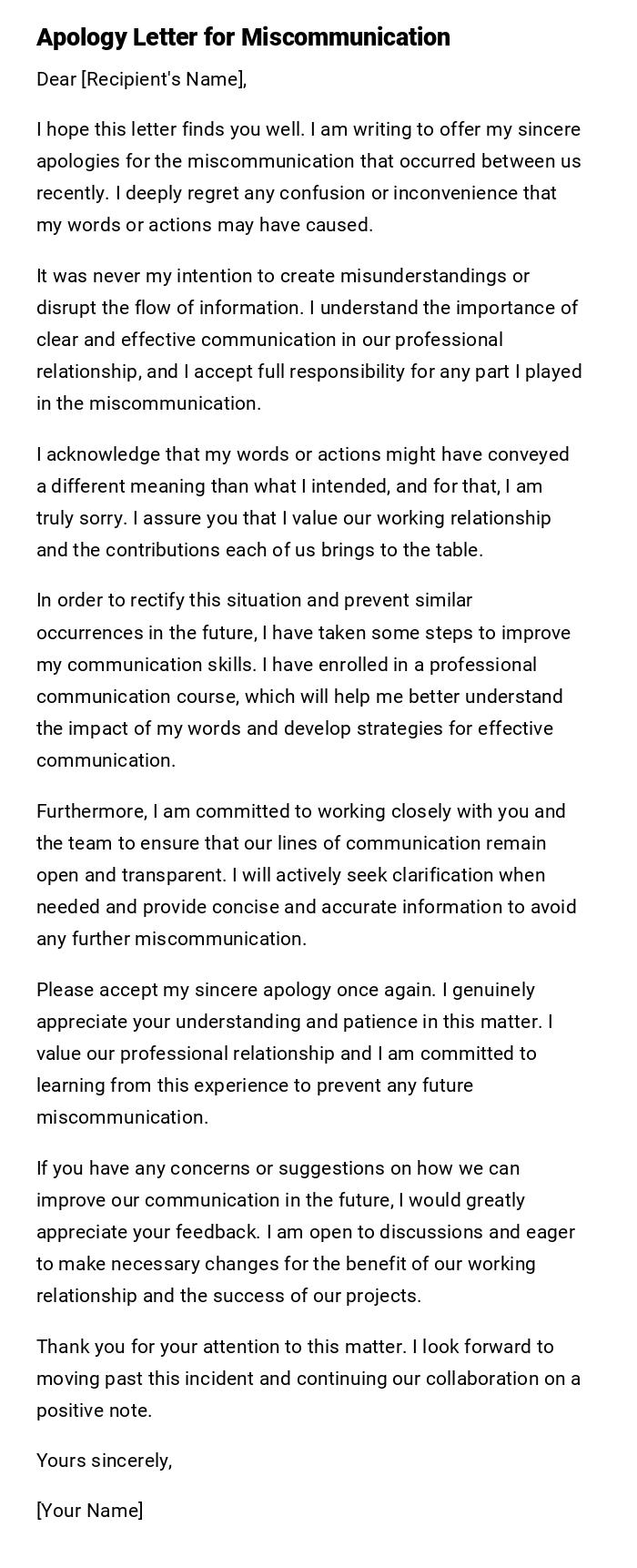
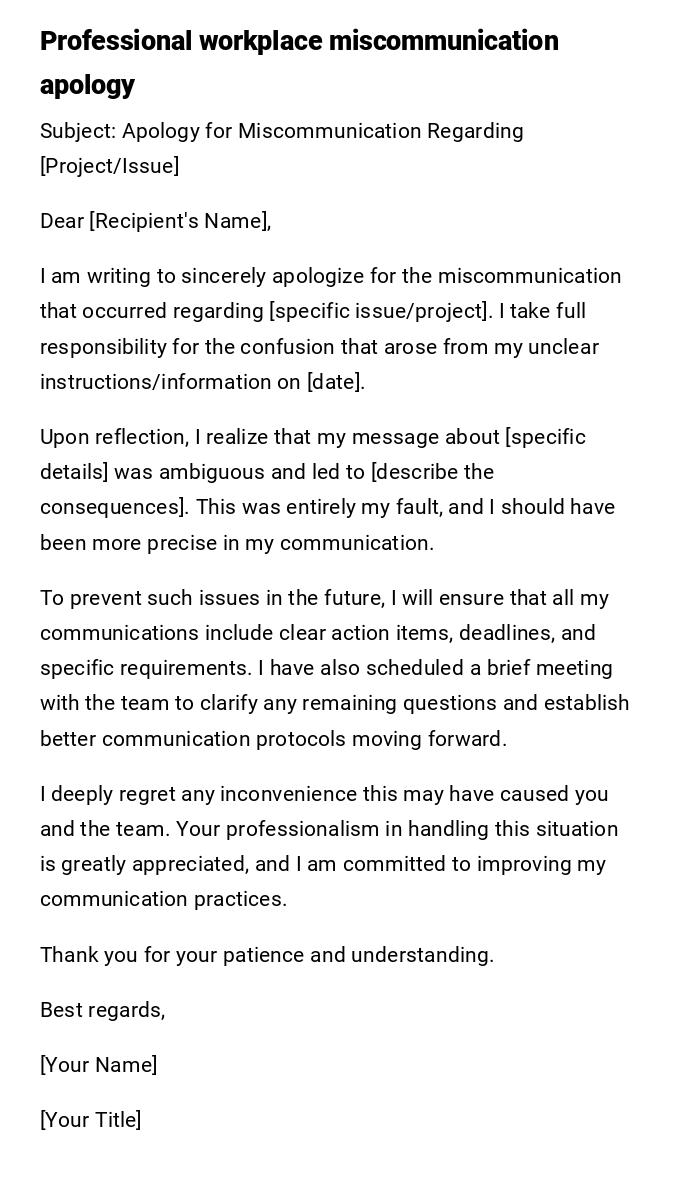
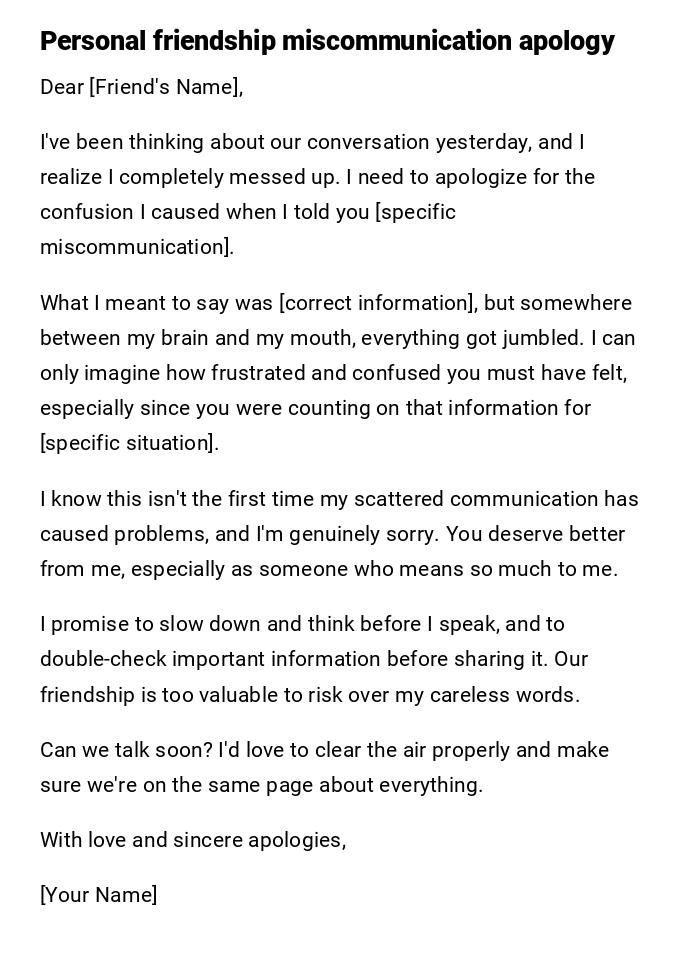
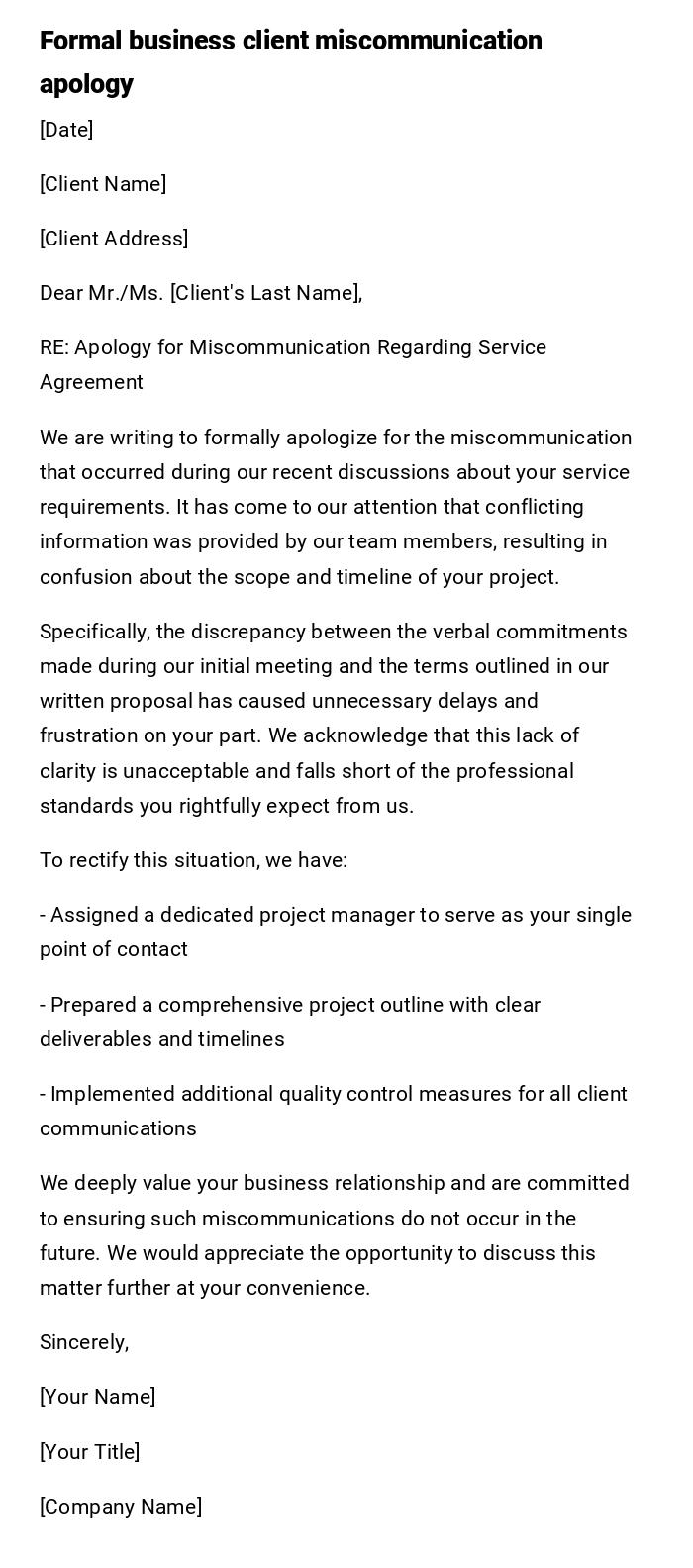
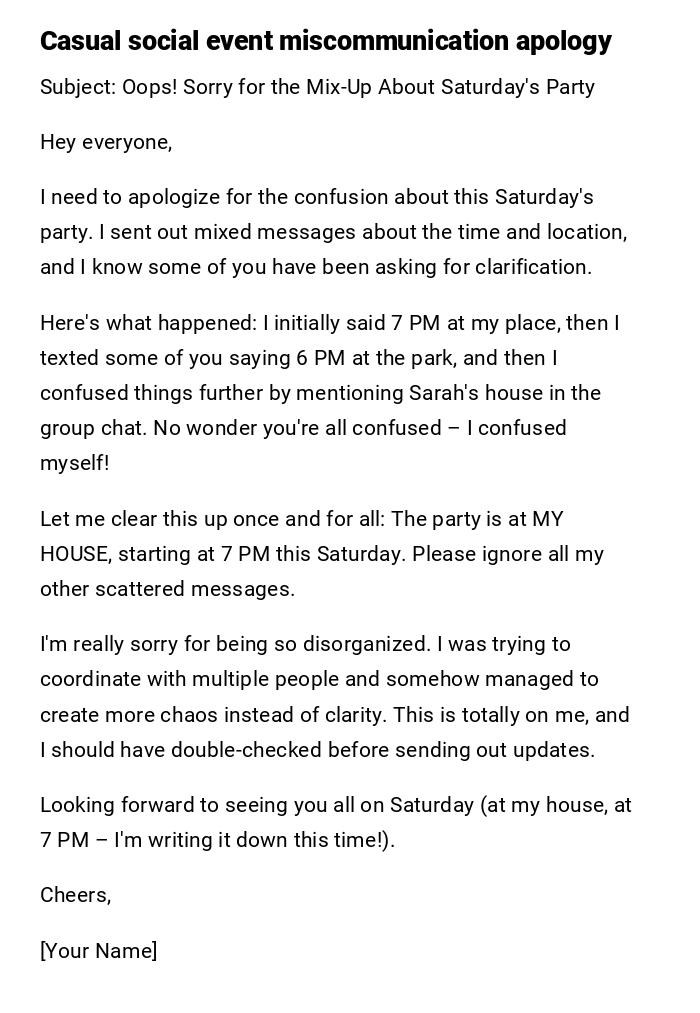
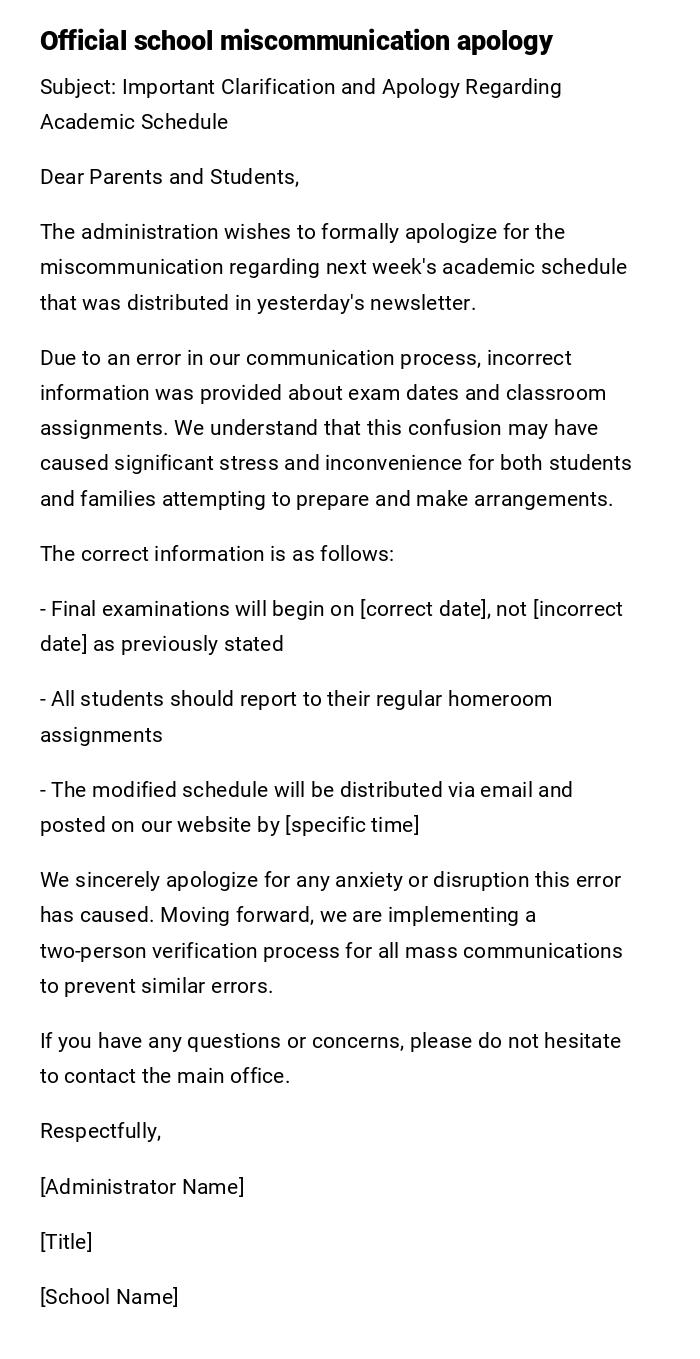
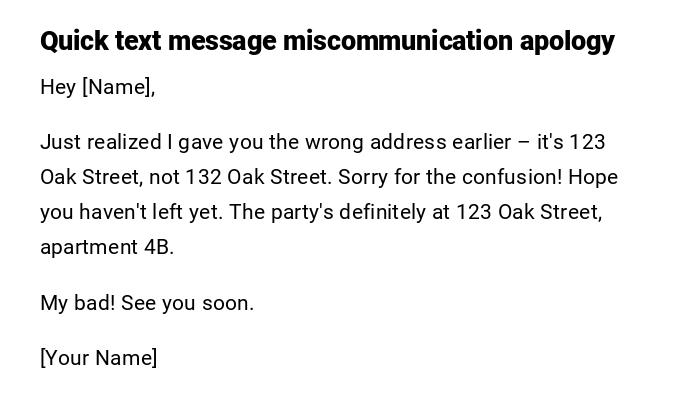
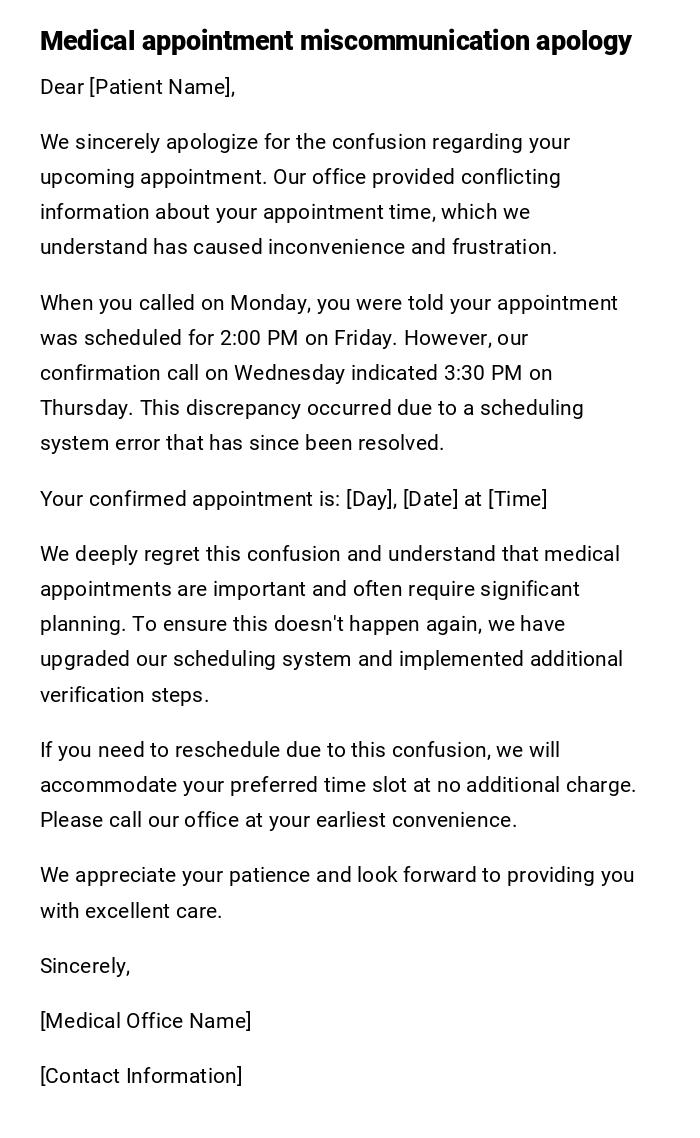

 Download Word Doc
Download Word Doc
 Download PDF
Download PDF